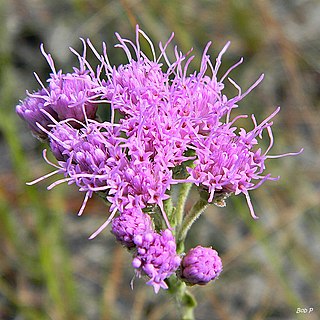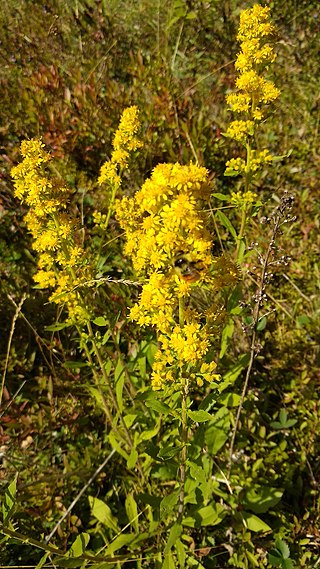
Gaillardia pulchella is a North American species of short-lived perennial or annual flowering plants in the sunflower family.

Chrysopsis are plants in the family Asteraceae native to the southern and eastern United States. All the species are found in Florida, although some are found in other states as well.

Ageratina herbacea is a North American species of flowering plants in the family Asteraceae known by the common names fragrant snakeroot and Apache snakeroot. It is native to desert regions of the southwestern United States and northern Mexico. It grows in rocky slopes in conifer forests and woodlands.

Carphephorus is a genus of North American plants in the family Asteraceae. They are native to the southeastern United States from Louisiana to Virginia. Plants of this genus are known commonly as chaffheads.
Sclerolepis is an aquatic plant native to the eastern United States. It has only one known species, Sclerolepis uniflora, the pink bogbutton. It lives in ponds and other wet areas. When water is abundant, the plant lives underwater, with long stems and flaccid, elongated leaves, and does not flower. When the water level drops, it assumes a form more familiar in terrestrial plants, with an erect stem, and flowers in summer to fall. The flowers are pink.

Cirsium lecontei, often called the Le Conte's thistle, is a North American plant species native to the southeastern United States. It is a perennial, or sometimes biennial, species of the tribe Cardueae within the family Asteraceae. It grows along the coastal plain from Louisiana to North Carolina.

Styrax americanus, the American snowbell or mock-orange, is a plant species native to the southeastern United States and the Ohio Valley. It has been reported from Texas and Florida to Virginia and Missouri. It generally grows in swamps and on floodplains and in other wet locations.

Solidago puberula, the downy goldenrod, is a plant species native to eastern North America from Nova Scotia and Ontario south to Florida and Louisiana. Two subspecies are commonly recognized:

Calycocarpum (cupseed) is a monotypic genus of flowering plants in the family Menispermaceae. The only species currently accepted is Calycocarpum lyonii endemic to the southeastern United States.

Burmannia capitata is a plant species widespread across the West Indies and much of Latin America. It grows in wet areas at elevations less than 100 m. It has been reported from Argentina, Belize, Bolivia, Brazil, Cuba, the Dominican Republic, Haiti, Jamaica, Puerto Rico, Trinidad & Tobago, Colombia, Costa Rica, French Guiana, Guyana, Honduras, southern Mexico, Nicaragua, Panamá, Paraguay, Suriname, Venezuela, and the United States

Parietaria floridana, common name Florida pellitory, is a plant species native to the southeastern United States, the West Indies, and much of Latin America. In the US, the heart of its range extends from Florida, to Georgia and North and South Carolina, with isolated populations reported in Mississippi, Louisiana, Texas, New Hampshire, Kentucky and Delaware. Some populations in California have in the past been referred to as P. floridana but are now regarded as a separate species, P. hespera.
Chaptalia albicans, the white sunbonnet, is a plant species native to Mexico, Central America and the West Indies. It is known from Jamaica, Cuba, Guatemala, Belize, Honduras, southern Florida, the Bahamas, Hispaniola, Puerto Rico, San Luis Potosí, Veracruz, Yucatán, Campeche and Chiapas.

Sagittaria platyphylla, the delta arrowhead, broad-leaf arrowhead or delta duck-potato, is a plant species native to the eastern United States.

Balduina uniflora, commonly called oneflower honeycombhead, savannah honeycombhead or oneflower balduina, is a North American species of plants in the sunflower family. It is native to the southeastern United States. It is the type species of the genus Balduina.

Balduina angustifolia, the coastal plain honeycombhead, is a North American species of plants in the sunflower family. It is native to the southeastern United States.
Chaptalia texana, common name silverpuff , is a North American species of plants in the family Asteraceae. It is native to Mexico, Texas, and New Mexico.

Facelis retusa, the annual trampweed, is a South American species of flowering plant in the family Asteraceae. It is native Brazil, Bolivia, Paraguay, Uruguay, northern Argentina, Chile; naturalized in parts of Africa, Australia, and North America including the southeastern and south-central United States, and considered as a noxious weed in some of those places.

Lactuca floridana, commonly known as woodland lettuce, Florida lettuce, or false lettuce is a North American species of wild lettuce. It is native across much of central Canada and the eastern and central United States.
Gaylussacia tomentosa, commonly known as the hairy dangleberry or hairytwig huckleberry, is a plant species native to the coastal plains of the southeastern United States.

Hypericum suffruticosum, known as pineland St. John's-wort, is a species of flowering plant in the St. John's wort family, Hypericaceae. It is native to the Southeastern United States.
















